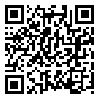BibTeX | RIS | EndNote | Medlars | ProCite | Reference Manager | RefWorks
Send citation to:
URL: http://journal.zums.ac.ir/article-1-1493-en.html

 , Mohammad Hussein Arjangyan2
, Mohammad Hussein Arjangyan2 
 , Bashir Hajibeigi2
, Bashir Hajibeigi2 
 , Hojat Afradi2
, Hojat Afradi2 
 , Mahnaz Aghaeepour3
, Mahnaz Aghaeepour3 
 , Farhad Razjoo4
, Farhad Razjoo4 
 , Shahin Sharifi5
, Shahin Sharifi5 
 , Peyman Eshghi6
, Peyman Eshghi6 

2- Thalassemia Clinic, Research Center of Iranian Blood Transfusion Organization, Tehran, Iran
3- Flowcytomery Section, Research Center of Iranian Blood Transfusion Organization, Tehran, Iran
4- Microbiology Lab, Research Center of Iranian Blood Transfusion Organization, Tehran, Iran
5- Quality Control Lab, Research Center of Iranian Blood Transfusion Organization, Tehran, Iran
6- Mofid Children Hospital,Shahid Beheshti University of Medical Sciences, Tehran, Iran
Background and Objective: Leukocyte filters are effective for WBC reduction but they cannot inhibit passing plasma proteins and as a result repeated protein entry may produce allergic transfusion reactions. To deal with this problem, washed RBC method is used. The traditional wash method is an open system through which waste products are carried away in sewers with the risk of environmental pollution. Newly introduced approach for washed RBCs consists of a closed system whereby waste products enter into a bag. In this study, the two methods were compared.
Materials and Methods: The two open and closed wash methods were compared in terms of health system, leukoreduction, risk of transmission of infection and quality control. In each method, 100 bags were washed, coded and then transmitted to different units of blood culture, flowcytometry as well as quality control. The data were collected and analyzed by SPSS14.
Results: 200 bags (100 for each method) were studied. Microbiologically, there were no positive results for any of the methods. In quality control also there was not any significant difference in the two methods. In flowcytometry, we didn’t observe any significant correlation in leukocyte count in the two methods before washing (p=0.072), however. The correlation between them after washing (p<0.0001), demonstrating that the new method was better for leukoreduction.
Conclusion: The new washing system method was a superior way because it involves a closed system where waste products are discharged into a side bag and disposed as hospital waste. Meanwhile, this approach is more convenient for leukoreduction. In our country, since we still need a washing system for some transfusions, this method is deemed to be a decent and practical one because it impedes environmental pollution.
Received: 2011/06/8 | Accepted: 2014/06/22 | Published: 2014/06/22
| Rights and permissions | |
 |
This work is licensed under a Creative Commons Attribution-NonCommercial 4.0 International License. |


